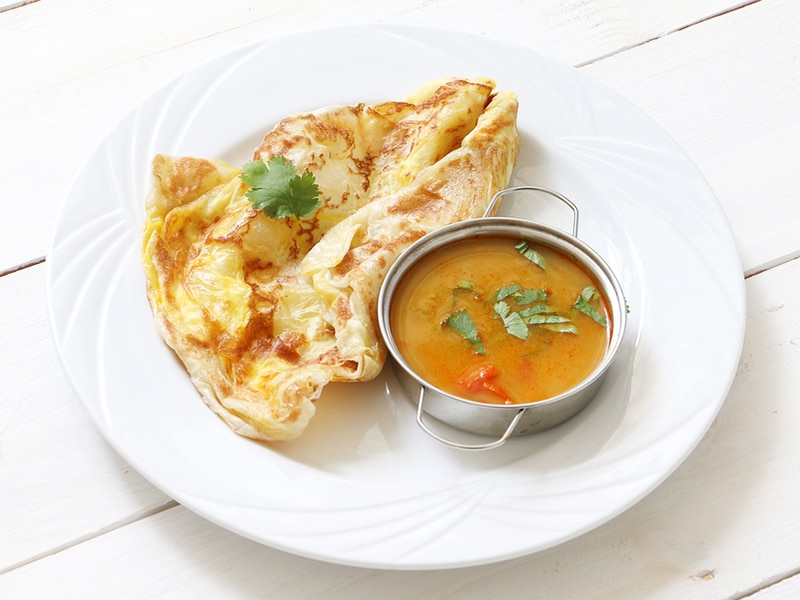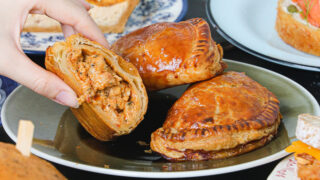One of Singapore’s greatest assets is its wet markets. They’re full of exotic, authentic food, and you can find some of the nation’s oldest butchers and fishmongers chopping, cutting, scaling and filleting fresh ingredients any way you desire. Among the most colourful of these bastions of all foods fresh and local? Tekka Centre in Little India.
Tekka Market has been the heart and soul of Little India since the early days, when the area was called Kandang Kerbau after the buffalo slaughterhouses operating on what is now Buffalo Road. Organised by type of food, the market is easy to navigate and explore. On this particular walk, we’ll make a loop around the market, starting at the steps fronting Serangoon Road.
Staying to the left side of the complex, you pass many hawker stalls selling predominantly Muslim and Indian prepared food – likely to give you a sudden craving for briyani. So start your food walk with a plate of this turmeric-laced rice dish at the popular Allauddan’s Briyani (#01-232). Select chicken, fish or mutton from the enormous steel vats on the counter, add a side of zesty curry gravy, and dig in. It’s hard to find a better version of this dish in any hawker centre.
Wet Market
Continue down the aisle picking and eating your way through savoury Indian treats like samosas and flat breads and several sweet stalls. At the end, bear to the right as the pathway leads toward the wet market.
Entering this section you first reach the poultry area, where whole chickens line glass cases and the vendors await your cutting instructions. Or just buy your chicken whole, which here means intact from head down to gnarly toenails. Beyond, you will see the market’s wide main aisle, with numerous fishmongers on the right and butchers on the left.
It’s in this area where the term “wet market” lives up to its name; the floors can be slippery from periodic hosing to wash away the fleshy detritus of a totally authentic market. For some of the biggest selection of the sea’s bounty, visit Lee Yit Huat Trading where, if they don’t have it, you don’t need it.
Continuing down the aisle, you’ll pass Indian spice stalls, where you can get masalas and curries custom-blended to your personal preference, along with dried goods and exotic spices. Down one aisle on the left you’ll see stacks of eggs, the best being the minimally processed kampong eggs. Back on the main drag, stop at the roasted meat stall to pick up some bulk cuts of char siu or siew bak pork or a roasted duck or chicken to take home. Then follow the sounds of soothing jazz to the far end of the market and Chia’s Vegetables Supply (#01-88). Here, Victor Chia and his brother will guide you to imported fresh items not found in most markets. If it’s a hard-to-find vegetable and you need it, Victor probably has it.

Hawker Centre
Continuing your loop through the narrow aisle of green vegetables and past stalls piled high with fresh tropical fruits, you come back to the market’s large hawker centre hugging an open courtyard with bright sun and cooling breezes. This courtyard separates the predominantly Muslim and halal food offerings on the left from the Chinese stalls on the right.
Prata, briyani & rojak
On the left side, be sure to visit Prata Saga Sambal Berlada (#01-258). Order a fresh-made roti prata; they’re so good the Culinary Institute of America flew the prataman to America to teach chefs how to make it. One bite of the flaky dough dipped in his tangy gravy and you’ll understand why.
If you didn’t grab a plate of briyani when you first entered, there are many other options available. They include Haniffa’s Briyani Specialist (#01-256) where mammoth vats of steaming rice and meat await under cloth-covered lids.
By the way, if you’re wondering whether to order a lamb dish or a mutton dish, here’s brief rundown on this popular ingredient at Tekka. Both come from sheep: the difference lies in the age of the animal, which affects the tenderness, flavour and price of the meat. Lamb is a sheep under one year of age; a spring lamb is under three months. Once a young sheep gets its first two teeth, it finds itself in that awkward, teenage period when it’s referred to as hogget. Two years later, it graduates to adulthood and is now full-blown mutton, with rich, intense red flesh and gleaming fat.
Close to Haniffa’s is Haji Johan Temasek India Rojak (#01-254). This stall offers a wide selection of vegetables, poultry and seafood char kueh dough fritters in a trademark orange batter. Must-tries are the giant prawn vadai, consisting of large, whole prawns in a moist doughnut of flour and spices. Also excellent are the tiny prawn vadai, handfuls of baby shellfish fried to a bronzed clump of goodness.
Duck, porridge & more
Numerous stalls along the courtyard’s right side offer Chinese selections, including fresh juices, dumplings, roasted meats and deep-fried bananas. Among them, on the far right, is Heng Gi Goose and Duck Rice (#01-335). This is a special place where informed foodies flock to for exceptional old-school duck and assorted pork parts. Don’t let the sparse décor fool you; the tender duck is cooked to perfection. It’s served over flavourful rice and doused with an earthy, profoundly rich braising broth unlike any other. Order it with a side of tofu, a tea-stained egg and a garnish of coriander. Or be daring and try the slippery duck feet or braised pig face – it’s better than you think!
If duck isn’t your thing, step over to Swee Heng Teochew Porridge Rice (#01-332/3). Here you’ll find seafood porridge, fishcakes and a host of other classic Teochew dishes. Wandering past the other stalls in the parallel aisles, you’ll find so much good food that you’ll want to return for more.
Your loop path ends back where you started. Before you leave, though, take the escalator to the second level, where stalls of vivid Indian fabrics, clothing and family goods will amaze you. Back on the street level, the market’s perimeter is ringed with often-overlooked shops selling everything from kitchenware and jewellery to music and food.
Wet markets are found in many neighbourhoods dotted around the island and are part of Singapore’s very social fabric; but Tekka, arguably the best of them all, is a cultural and culinary whirl that you will never forget.
For Newcomers to Tekka
Just how do you navigate a large, bustling wet market packed with flora and fauna you don’t recognise?
- First and foremost, don’t be timid.
- Having a grocery list will force you to find the areas of the market that most interest you, and will open a Pandora’s box of items you’d previously never considered. You’ll be pleased by the much lower prices than you pay at Western-style supermarkets.
- Talk to the vendors about unusual items, how they taste and how to prepare them. Chances are you’ll receive a sample and a whole lot more.
- Prices tend to come down the better a vendor knows you, so repeat visits can be rewarding!
- Finally, say hello to people even if they don’t know you. Smile and laugh at yourself and they’ll laugh with you (not at you!). In other words, become a regular and discover the joy of walking through a chaotic, crowded wet market with people waving to you, shaking your hand and offering tastes of things you’ve never seen.
We hope you found this interesting; click here if you’d like to read more.















